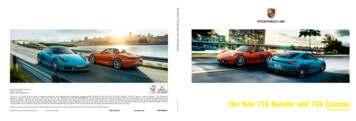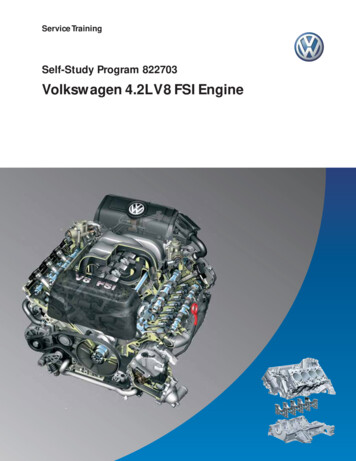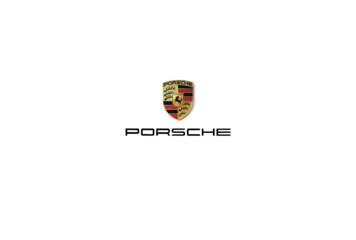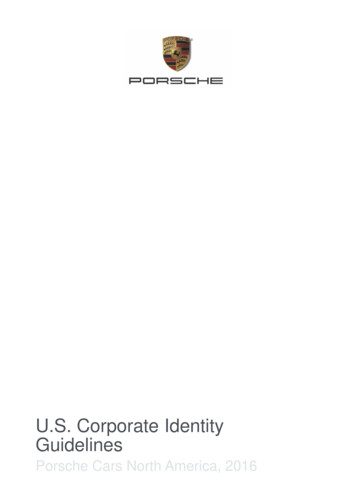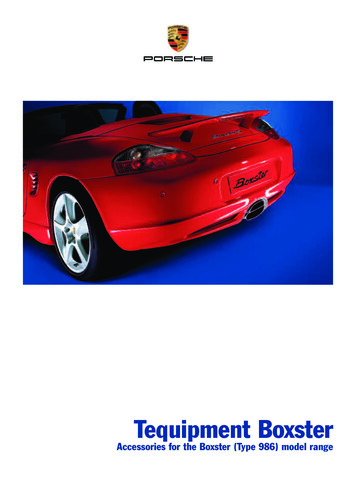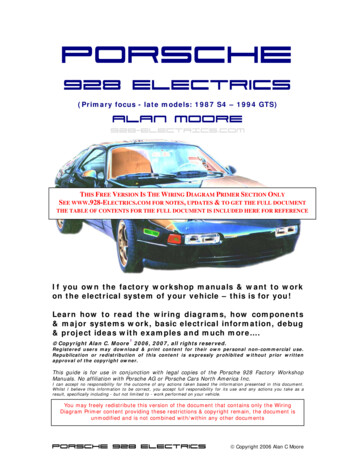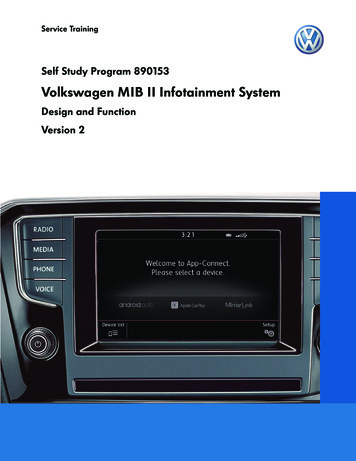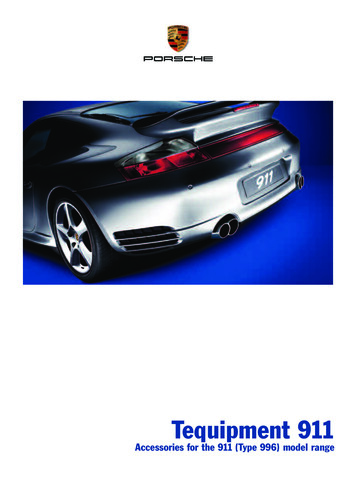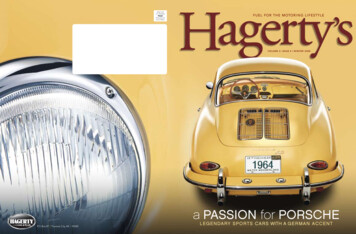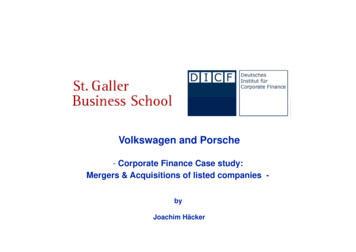
Transcription
Volkswagen and Porsche- Corporate Finance Case study:Mergers & Acquisitions of listed companies byJoachim Häcker
What is the macro view of this case study?Small fish tries to eat bigg fish ((financial figuresgare end of 2005 and rounded):)VW: Market cap: 16 bnBook value: 24 bnCash and cash equivalent:q 8 bn( 4 bn marketable securities)Porsche: Market cap: 11 bnB k value:Bookl 3 4 bn 3.4bCash and cash equivalent: 3.6 bnVW Porsche case study – by Joachim HäckerSeite 1
What is the macro view of the case study?What is the agenda of this presentation?11. Basic understanding:How did the small fish try to eat the big fish - the takeover process!2. Question 1:What does Porsche need to clarify in order to successfully attack the big fish?3. QQuestion 2:How can Porsche make sure that nobody realizes that the small fish is about to eat the big fish?4. Question 3:How can Porsche finance the attack?VW Porsche case study – by Joachim HäckerSeite 2
1. Basic understanding of the takeover process: The situation of VW in 2005P/B ratio of VW,, Daimler-Chrysleryand BMW,, values rounded off ((status: 2005 end)) bn bn bnVW: Lowest P/B ratioVW Porsche case study – by Joachim HäckerSeite 3
1. Basic understanding of the takeover process: The situation of VW in 2005Porsche: Growth of turnover from 2000/2001 – 2004/2005CAGR off 10,2%,VW Porsche case study – by Joachim HäckerSeite 4
1. Basic understanding of the takeover process: The situation of VW in 2005Porsche: Growth of net pprofit marging from 2000/2001 – 2004/2005Net pprofitf marging almost doubled ffrom 2001 to 2005VW Porsche case study – by Joachim HäckerSeite 5
1. Basic understanding of the takeover process: The situation of VW in 2005Return on Equityq y Ratio,, Porsche and the competitorsp(Status(as of: 2004 or 2004/2005))Incredible highg pprofitabilityfy off PorscheVW Porsche case study – by Joachim HäckerSeite 6
1. Basic understanding of the takeover processPorsche tries to acquire VW in 4 phases:VW Porsche case study – by Joachim HäckerSeite 7
Phase 1: Porsche entered in VW?Before September 25th, 2005, Porsche held a 5% minority share in VW. Shortly thereafter, theirh ldiholdingsiincreasedd tto ca. 19%.19% AdditiAdditionally,ll PPorscheh hhadd optionstioff anotherth 3%.3% VWshareholding structure after the entry of Porsche (status as of: autumn 2005):Porsche was the biggest principal shareholder, followed by the Federal State of LowerSaxony. Through options, Porsche was able to increase its interest to more than 20%, thusobtaining a blocking minority statusVW Porsche case study – by Joachim HäckerSeite 8
Phase 1: What was the Investor Reaction to Porsche’s entry into VW?VW ordinaryy share,, pprice movement from 12th Sep.p 2005 – 30th Sep.p 2005Porsche announced having a blocking minorityBasicallyy no effectff on VW share pricepVW Porsche case study – by Joachim HäckerSeite 9
Phase 1: What was the Investor Reaction to Porsche’s entry into VW?Tradingg volume of ordinaryy VW shares,, 12th Sep.p 2005 – 30th Sep.p 2005The trend line shows above average trading in VW securities from September 21st throughp, Porsche seemed to have acquiredqVW ordinaryy shares,, thus27th. Duringg this period,increasing demand .VW Porsche case study – by Joachim HäckerSeite 10
Phase 1: What was the Investor Reaction to Porsche’s entry into VW?Price movement of Porsche from 12th Sep.p 2005 – 30th Sep.p 2005Porsche shareholders were sceptical about the company’s press release. In fact, after the adh announcement,hoct PPorsche’sh ’ sharehpricei ddroppedd 1010.4%.4%VW Porsche case study – by Joachim HäckerSeite 11
Phase 1: What was the Investor Reaction to Porsche’s entry into VW?Traded volume of Porsche share from 12th Sep.p 2005 – 30th Sep.p 2005The first trading day after Porsche’s announcement of its minority interest in VW, tradevolume rose. Accordingly, the falling price of the shares indicate that many investors soldtheir Porsche stock soon after the company’s announcement.VW Porsche case study – by Joachim HäckerSeite 12
Phase 1: Porsche might acquire VW: What are the threats and caveatsSWOT analysis,y , Porsche takes over VWVW Porsche case study – by Joachim HäckerSeite 13
Phase 2: Edging towards the 30% mark (November 2006)Co c d g withCoincidingw thee announcementou ce e ofo itss 18.5%. % minorityo y shares e (September(Sep e be 2005),), Porscheo sc eannounced that the scope of its engagement with VW would not, in any case, come to requireissuance of a mandatory offer to the other shareholders:Fifteen months, that very thing happened!To accomplish this, Porsche did not buy VW shares directly: Instead, it (again) acted throughoptions. This way, Porsche effectively “sneaked” its way to the 30% mark within one year.The initial 8.5% share was increased to 21% plus, and in November 2006, the companyexercised VW common stock options at around 4%, with holdings totaling more than 25%.Two days later Porsche’s share increased to 27.4%.VW Porsche case study – by Joachim HäckerSeite 14
Phase 3: Crossing the 30% hurdleAccording to the German Stock Corporation Act,Act when Porsche crossed the 30%30%-threshold,thresholdPorsche was bound by contract to submit a bid to the other shareholders for the remainingordinary and preference shares.Porsche publically announced that it did not intend to acquire VW.Porsche limited bidding to the legally prescribed minimum price of 100.92 euro per ordinaryshare, and 65.54 euro per preferred share.The acceptanceppperiod extended from Aprilp 30th to Mayy 29th 2007. At the end of this pperiod,, anordinary share listed at 111.39 euro and a preferred share at 74.54 euro.The pronounced discrepancy between the going rate and the actual market value (offer belowmarketk t value)l ) resultedlt d ini a 0.06%0 06% acceptancetrate.tVW Porsche case study – by Joachim HäckerSeite 15
Phase 4: Approaching the 75% hurdleDevelopmentpof VW common stock ((monthlyy keyy rates))On October 28th 2008 short sellers reacted with panic buys when Porsche’s stated that itheld 42.6% VW common stock plus 31.5% cash-settled call options in bonds; and as aresult, drove prices up (taking into account Lower Saxony’s major share, the free floatdiminished to 5.9%).VW Porsche case study – by Joachim HäckerSeite 16
Phase 4: Approaching the 75% hurdleTradingg volumes of VW common stock,, monthlyy keyy ratesShortly before Porsche’s entry, the trading volume of VW common stock rose sharply.Likely, in addition to investors, banks that had concluded option contracts with Porscheppurchased VW securities in order to reduce risk,, furtherfdrivingg upp demand.VW Porsche case study – by Joachim HäckerSeite 17
Phase 4: Approaching the 75% hurdleVW share structure as in 2009 (p(provided that QQatar Holdingg LLC would exercise all optionspheld))The VW stockThk - intrinsici i i llackk off didiversificationifi i becausebtheh majorityj i off theh stockk isi ini thehhands of three major shareholders.Moreover, the stock is “market-dependent,” because the three major shareholders don’tactivelyti l tradet d ini theth market;k t andd havehinsteadi t d maded long-termltinvestments.ittVW Porsche case study – by Joachim HäckerSeite 18
Phase 4: Approaching the 75% hurdleTradingg volume of VW common stock,, monthlyy keyy rates,, Nov. 08 – Nov. 09DeclineDli ini traded volume,longoingi sinceiNovemberNb 2008 off VW shares.hThThe tradabilityd bili off thehstock has decreased. This puts the stock at risk of private shareholders, who favour shortterm investments. The risk remains that the stock will not immediately re-sell. Theddecreasingi demanddd willill lowerltheth pricei further.f thVW Porsche case study – by Joachim HäckerSeite 19
Phase 1–4 Summary: How and why did the VW share price increase?November 2006 Porsche raised its VW share to 2727.4%.4% The price of VW common stock was at82.25 euro, and had nearly doubled in a year. From October to November 2006, the trade volumeincreased by 206%.January – March 2007 The tradîng volume showed another enormous increase (251%) fromJanuary to March. By March, VW stock was at 112.50 euro. After Porsche increased its share toabove 30%, media reports that indicated an imminent acquisition of VW were published.publishedAccordingly, over the next months, share prices were driven even higher.October 2007 VW stock held at 197.90 euro,, correspondingpg with a 387% increase in three yyears. Inthe following months, the rate slipped to 150 euro; possibly because of the ECJ’s dismissal of VWlaw.March 2008 Porsche published a press release, according to which the supervisory board agreed toa majority share in VW. Then, VW common stock increased again, this time exceeding the 200 euromark in the months that followed.VW Porsche case study – by Joachim HäckerSeite 20
Phase 1–4 Summary: How and why did the VW share price increase?OctoberOb 2008 TheTh financialfii l crisisi i reachedh d theh GermanGmarket,k VW stockk was resistant,iinitially,i i i lland on October 28th 2008, worth more than 1,000 Euro. Short sellers reacted with panic buys whenPorsche’s stated that it held 42.6% VW common stock plus 31.5% cash-settled call options inb d andd as a result,bonds;lt drovedpricesiup. AndA d takingt ki intoi t accountt LowerLSaxony’sS’ majorj share,hdiversified holdings diminished to 5.9%.November 2008 Porsche triggered 5% of its call options based on cash settlementsettlement. The VW ratenormalized, but the stock was still overvalued.January 2009 Porsche attained a 50.76%50 76% majority share,share and the rate of VWVW’ss shares levelled offabove 200 Euro. By May 2009, it was finally clear that Porsche could not stem the takeover.August 2009 Qatar entered into VW, as its third major shareholder.VW Porsche case study – by Joachim HäckerSeite 21
22. Question 1: What does Porsche need to clarify in order tosuccessfully attack the big fish?Answers to Question 1:1: Constant improvement in terms of profitability and liquidity of business operations2: The complete abolition of VW law3: Financial assistance from the banks in the form of creditsVW Porsche case study – by Joachim HäckerSeite 22
22. Answer 1: Constant improvement in terms of profitability andliquidity of business operations?Porsche’sPh ’ car salesl ddeclineli(comparing the first half of 2007/2008 with the first half of 2008/2009)The economic crisis hit all global automotive companies. Also Porsche could selll cars. InlessI response tot dwindlingd i dli salesl figures,fiPorschePh hadh d tot curbb itsit production.d tiVW Porsche case study – by Joachim HäckerSeite 23
22. Answer 1: Constant improvement in terms of profitability andliquidity of business operations?Porsches proceeds from share stock option 1st half-year 2008/2009Porsche succeeded in quadrupling its profit, due to the 6.8 billion euro profitgeneratedt d throughthh VW optionti sharingh iVW Porsche case study – by Joachim HäckerSeite 24
22. Answer 1: Constant improvement in terms of profitability andliquidity of business operations?Despite the sales decline Porsche could increase its profitability. However:1) Profitability: Profits from the cash-settled options depended upon an increasing VW shareprice.2) Liquidity: Further, in addition to the sales slump, net liquidity decreased by nine billioneuro, when Porsche rushed to purchase enough VW stock to increase its holding form 30%to 50%. As it turned out, Porsche was unable to fund the acquisition through its own means.The operatingpg pprofitabilityfy and liquidityqy was not constant but declininggVW Porsche case study – by Joachim HäckerSeite 25
2. Answer 2: Complete abolition of VW law?Once the ECJ issued complaint regarding the alleged illegality of certain sections of VW law,Parliament, in November 2008, approved a new version thereof.Accordingly, special delegation rights in the VW Supervisory Board once reserved forrepresentatives from Central and Lower Saxony (§ 4 paragraph 1 VW law) were removed.Further, each shareholder was immediately entitled to exercise his full voting rights, which wereno longer restricted to 20%, as was stipulated by § 2 paragraph 1 of VW law.However, certain decisions made during general meetings still required approval by an 80%majority.The controlling stake remained at 20%, and Lower Saxony retained its right to veto.PPorscheh was preventedt d fromfsigningi i a dominationd i ti agreementt andd a profitfit transfertf agreement.tVW Porsche case study – by Joachim HäckerSeite 26
2. Answer 3: Financial assistance from the banks in the form of credits1) Economic crisis changed lending: Under normal circumstances, the banks would havesupplied Porsche with the necessary capital. But the new credit climate following the globaleconomic crisis necessitated new lending standards, which Porsche certainly felt during its 10billion euro (originally 30bn euro) refinance in spring, 2009.2) Mr.M HärterHä t triedt i d tot “outsmart”“ tt” theth banks:b k Porsche’sPh ’ bbehaviourh idduringi theth reorganizationi tiof its credit terms factored in to the banks’ decision making. Porsche failed to utilize the creditextended to it in March 2008, to expand its stake in VW, as was originally proposed. Instead,Porsche invested the loanloan, for a high return; effectively generating capital that Porsche wouldapply to its interest payments.The relationshipp “Porsche and banks” was coolingg downVW Porsche case study – by Joachim HäckerSeite 27
33. Question 2: How can Porsche make sure that nobody realizes thatthe small fish is about to eat the big fishAnswers to Question 2:1: Edging towards the 30% mark2: Submitting a low tender offer3: Using options (does not need to be reported to the BaFin)VW Porsche case study – by Joachim HäckerSeite 28
3. Answer 1: Edging towards the 30% markWhat are the thresholds and therights of the shareholders?VW Porsche case study – by Joachim HäckerSeite 29
3. Answer 1: Edging towards the 30% markCo c d g withCoincidingw thee announcementou ce e ofo itss 18.5%. % minorityo y shares e (September(Sep e be 2005),), Porscheo sc eannounced that the scope of its engagement with VW would not, in any case, come to requireissuance of a mandatory offer to the other shareholders:Fifteen months, that very thing happened!To accomplish this, Porsche did not buy VW shares directly: Instead, it (again) acted through itsoptions. This way, Porsche effectively “sneaked” its way to the 30% mark within one year.The initial 8.5% share was increased to 21% plus, and in November 2006, the companyexercised VW common stock options at around 4%, with holdings totaling more than 25%.Two days later Porsche’s share increased to 27.4%.Porsche tried to pplayy the “goodgguy”g y as longg as theyy were below the threshold off 30%VW Porsche case study – by Joachim HäckerSeite 30
3. Answer 2: Submitting a very low tender offerAccording to the German Stock Corporation Act,Act when Porsche crossed the 30%30%-threshold,thresholdPorsche was bound by contract to submit a bid to the other shareholders for the remainingordinary and preference shares.Porsche publically announced that it did not intend to acquire VW.Porsche limited bidding to the legally prescribed minimum price of 100.92 euro per ordinaryshare, and 65.54 euro per preferred share.The acceptanceppperiod extended from Aprilp 30th to Mayy 29th 2007. At the end of this pperiod,, anordinary share listed at 111.39 euro and a preferred share at 74.54 euro.The pronounced discrepancy between the going rate and the actual market value (offer belowmarketk t value)l ) resultedlt d ini a 0.06%0 06% acceptancetrate.tVW Porsche case study – by Joachim HäckerSeite 31
3. Answer 3: Using optionsUntil the beginning of 2007, it was not necessary to report call options with redemptive rightsto the German Federal Financial Supervisory Authority (BaFin) even if the investor’s holdingsmet or exceeded the registration threshold.thresholdPorsche ffound a legalg loophole!pVW Porsche case study – by Joachim HäckerSeite 32
4. Question 3: How can Porsche finance the attack?AAnswersto QQuestioni 3:31 Liquidity from operating business2 Instating Eurobonds and Hybrid Bonds3 Borrowing from a syndicate of international banks4 Profits from a smart options strategyVW Porsche case study – by Joachim HäckerSeite 33
4. Answer 1: Liquidity from operating business“Cash and cash equivalent”qas well as “marketable securities” of Porsche 2003 – 2005 ((in bn Euro))In 2003, 2004 and 2005 Porsche’s liquidity was excellentVW Porsche case study – by Joachim HäckerSeite 34
4. Answer 1: Liquidity from operating business“Porsche’s liquidityqy based on the financial yeary 2004/2005The current ratio shows that one quarter of Porsche’s then-current assets was enough tocover itsit short-termh ttobligations.bli tiMoreover,Mitsit 3.773 77 billionbilli euro debtd bt loadl d was sufficientlyffi i tlcovered by the positions “cash”, “marketable securities”, and “trade receivables”, whichadded up to 3.87 billion euro: Porsche was de facto completely debt-free.VW Porsche case study – by Joachim HäckerSeite 35
4. Answer 1: Liquidity from operating businessRatio comparison,p, Porsche 2004/2005 and VW 2004Profitability: Porsche’s Net Profit Margin was above-average with an outstanding coststructure. Here again, Porsche outperformed the other manufacturers. While BMW bookeda 5 cent per euro profit margin and Daimler-Chrysler, 1.74%, VW’s performance lagged at0 8%0.8%.Liquidity: Acquiring 18.5% of VW shares, plus 3.4% of its call options cost Porscheapproximately 33.33 billion euro - the shares were basically financed with operating liquidityliquidity.VW Porsche case study – by Joachim HäckerSeite 36
4. Answer 2: Instating one Eurobond and two hybrid bondsPorsche’ debt financingg was done via Eurobonds and hybridybondsPorsche’s Eurobond was split into the following two tranches:Porsche issued a Eurobond of 1.9 bn at the beginning of 2006VW Porsche case study – by Joachim HäckerSeite 37
4. Answer 2: Instating one Eurobond and two hybrid bondsPorsche’s issued the following two hybrid bonds:Porsche issued two hybrid bonds totaling 1 bn as well as 1 bn.VW Porsche case study – by Joachim HäckerSeite 38
4. Answer 3: Borrowing from a syndicate of international banksIncrease in Porsche’s liabilities to banks:In February 2008, Porsche completely exhausted its ten billion euro loan, taken out inearlyl 2007.2007 ThThe syndicatedi t iincludedl d d 15 bbanksk ((earlier:li 30 bbanks)k ) andd was hheadedd d bby ththefinancial institution Barclays. The credit line, granted with very favorable terms, wasoriginally earmarked to cover the payment from the original mandatory offer for theremaining VW shares.sharesVW Porsche case study – by Joachim HäckerSeite 39
4. Answer 4: Profits from a smart options strategyPorsche’s earningsg from options:pPorsche’s earnings from options: ca. 19bn in 2007/2008VW Porsche case study – by Joachim HäckerSeite 40
4. Answer 4: Profits from a smart options strategyPorsche’s pprofits from options:pPorsche’s profit from options: ca. 7bn in 2007/2008VW Porsche case study – by Joachim HäckerSeite 41
4. Answer 4: Profits from a smart options strategyBasic optionpterms of techniqueqStrike priceStrikeVW Porsche case study – by Joachim HäckerSeite 42
4. Answer 4: Profits from a smart options strategyPorsche held various options on VW shares (underlying) with a contractually determined strike price,divided into three types:ypType 1 - Long Call 1Porsche bought call options, which were designed for the delivery of shares, with a strike price thatwas in line with the share’s current market price.Type 2 - Long Call 2Porsche bought highly speculative call options, which were designed for cash compensation, with astrike price that significantly exceeded the share’s current market price.Type 3 - ShortSPutPorsche sold put options on VW shares to the banks. For the banks, these were protective put optionsused to safeguard against the effects of any decrease in VW share price.VW Porsche case study – by Joachim HäckerSeite 43
4. Answer 4: Profits from a smart options strategyFICTIONAL EXAMPLE1. Porsche buys a call option with a strike price of 70 euro, and a premium of 15 euro. Theoptionpcan be executed immediately.y2. Porsche buys an additional call option with later exercise date and a strike price of 130euro. The ppremium costs 10 euro, and the optionpis cash-settled.3. The VW share price listed at 85 euro.4. Scenario 1: On the exercise date of the second call, the VW share listed at 100 euro.5. Scenario 2: On the exercise date of the second call, the VW share listed at 130 euro.6. Scenario 3: On the exercise date of the second call, the VW share listed at 250 euro.VW Porsche case study – by Joachim HäckerSeite 44
4. Answer 4: Profits from a smart options strategyHow does the Porsche pposition on Longg Call 1 look like?Porsche’s profit per Long Call 1 0VW Porsche case study – by Joachim HäckerSeite 45
4. Answer 4: Profits from a smart options strategyHow does the Porsche pposition on Longg Call 2 look like ((Scenario 1-3)?)Porsche starts making profit when the VW shares exceed 140.Especially, if the shares are listed at 1,000 level!VW Porsche case study – by Joachim HäckerSeite 46
4. Answer 4: Profits from a smart options strategyPorsche‘s long call strategy (Long call 1 and 2) in a nutshell:-10-1585 (70 15)140 (130 10)VW Porsche case study – by Joachim HäckerSeite 47
4. Answer 4: Profits from a smart options strategyHow does Porsche‘s cash-settled strategy (Long call 2 and short put) look like?Porsche goes short on a put-contract with the banks. The strike price of the put option is 200 and the option is cash-settled. The received premium is 15 euro per Put.The Put and the 130-Call have the same exercise date.Porsche starts making profit when the VW shares exceed 162,5 ( 32,5- 37,5 5).Especially, if the shares are listed at 1,000 level!VW Porsche case study – by Joachim HäckerSeite 48
4. Answer 4: Profits from a smart options strategyVW common stock price (closing prices) when Porsche announced to have access to 74.1% .For a moment, VW’s market capitalization reached 295 billion euro.VW was the world’s most valuable company even outperforming Exxon Mobil.VW Porsche case study – by Joachim HäckerSeite 49
Porsche publically announced that it did not intend to acquire VW. Porsche limited bidding to the legally prescribed minimum price ofPorsche limited bidding to the legally prescribed minimum price of 100.92 euro per ordinaryeuro per ordinary share, and 65.54 euro per preferred share. The
